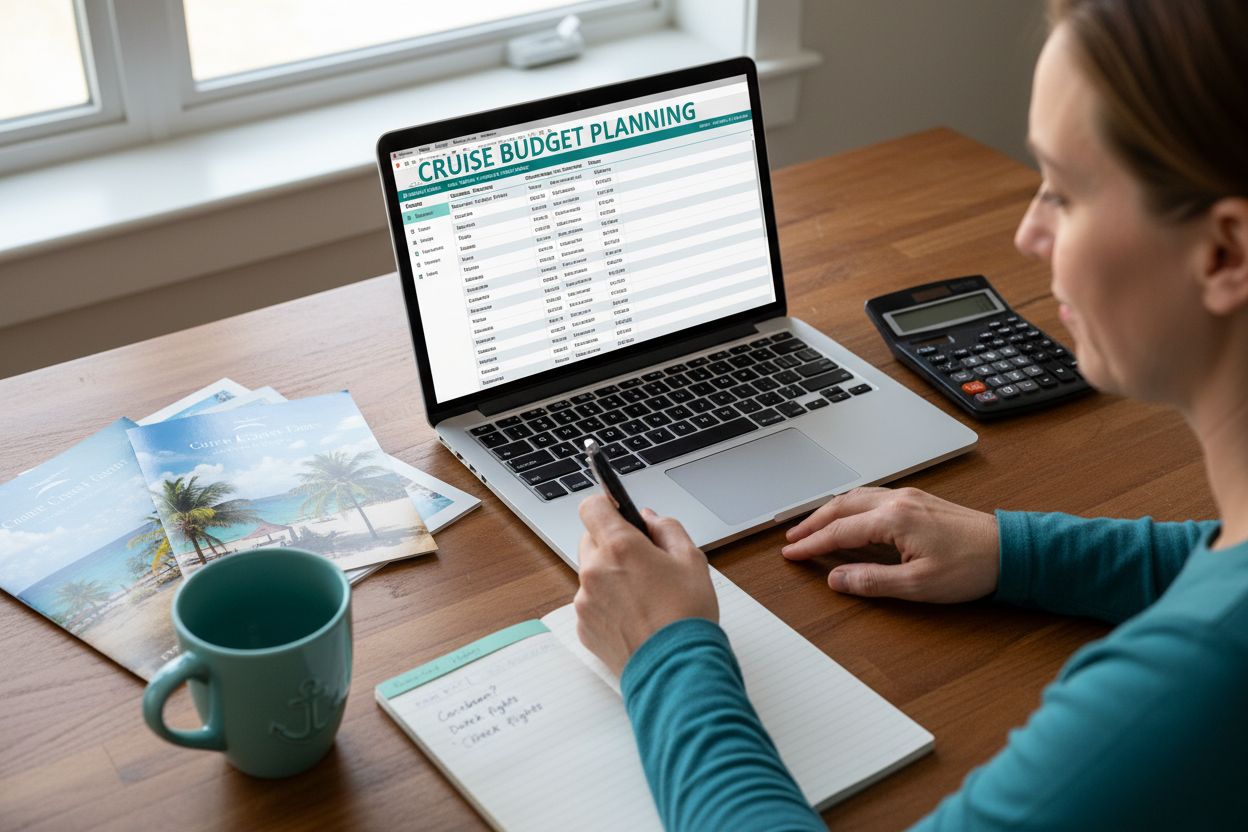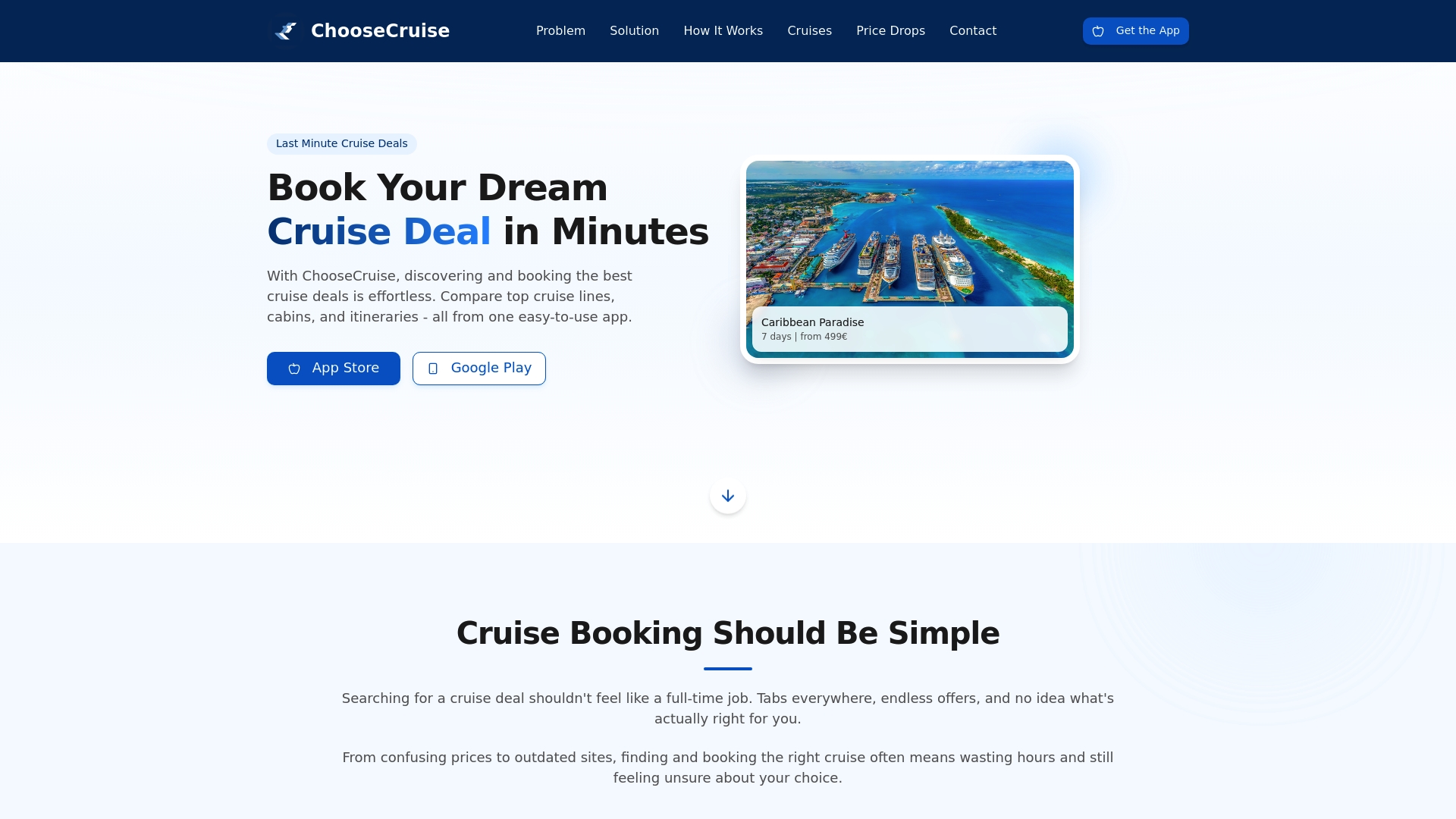Master Your Cruise Budget Planning Process Effectively

Planning a cruise can make your wallet feel lighter even before you set sail. Cruise expenses can sneak up fast, with experts noting vacation spending should stay under 10 percent of your annual income. Most people think buying the ticket is the only big step. That could not be more wrong. The real financial impact comes from the hidden costs and the careful planning that separates a stress-free trip from a budget-busting surprise.
Table of Contents
- Step 1: Determine Your Total Budget
- Step 2: Research Cruise Options And Costs
- Step 3: Break Down Your Expenses
- Step 4: Create A Savings Plan
- Step 5: Finalize Your Budget And Make Reservations
Quick Summary
| Key Point | Explanation |
|---|---|
| 1. Assess Your Total Budget | Determine your total disposable income for travel and categorize expenses for better control. |
| 2. Research Cruise Options Actively | Explore various cruise lines and pricing to ensure you choose the best value for your budget. |
| 3. Break Down Expenses Accurately | Categorize expenses into mandatory and discretionary to prevent budget overruns and ensure financial clarity. |
| 4. Develop a Savings Plan | Establish a monthly savings target with automated transfers for consistent progress towards your cruise funds. |
| 5. Finalize Budget and Make Reservations | Review your budget thoroughly before booking to confirm that it aligns with your savings and financial goals. |
Step 1: Determine Your Total Budget
Starting your cruise budget planning process begins with a clear and comprehensive understanding of your total available funds. This critical first step sets the foundation for every subsequent financial decision during your cruise preparation.
First, assess your total disposable income specifically earmarked for travel. Look beyond your regular savings and consider alternative funding sources such as tax returns, work bonuses, or dedicated travel funds you might have accumulated. Be realistic about what you can genuinely afford without creating financial strain.
Break down your total budget into specific cruise-related categories to gain granular control. These categories typically include:
- Base cruise fare
- Transportation to and from port
- Pre and post-cruise accommodations
- Onboard expenses
- Dining and entertainment
- Shore excursions
- Travel insurance
- Emergency buffer funds
Calculate your total budget by first determining your maximum comfortable spending limit. Financial experts recommend allocating no more than 5-10% of your annual income for vacation expenses. For a cruise specifically, consider using budgeting tools like Mint or YNAB to track and categorize potential expenses accurately.
Remember that cruise costs extend far beyond the initial ticket price. Onboard expenses can quickly escalate through additional services like specialty dining, premium drink packages, internet access, and spa treatments.
This table summarizes common cruise expense categories, their typical inclusions, and considerations to keep in mind as you build your detailed budget.
| Expense Category | Typical Inclusions | Budget Considerations |
|---|---|---|
| Cruise Fare | Accommodation, main dining, basic entertainment | Varies by cabin type and cruise line |
| Transportation | Flights, transfers, parking | Costs vary by port location |
| Onboard Expenses | Specialty dining, drinks, spa, Wi-Fi, activities | Often not included in base fare |
| Shore Excursions | Guided tours, activities, local attractions | Book independently for savings |
| Accommodations | Pre/post-cruise hotel stays | Align with cruise departure times |
| Insurance & Fees | Travel insurance, port fees, gratuities | Sometimes bundled, often separate |
| Emergency Buffer | Unexpected expenses | Add 15-20% buffer to total budget |
To verify you’ve completed this step successfully, you should have a comprehensive spreadsheet or financial plan that outlines every potential expense, with clear dollar amounts assigned to each category. Your total budget should feel comfortable, sustainable, and aligned with your broader financial goals. If the numbers cause significant stress or require extensive debt, it might be time to reconsider the trip’s timing or scale.
By meticulously determining your total budget upfront, you transform your cruise budget planning process from a potential source of anxiety into a structured, manageable journey toward an incredible vacation experience.
Step 2: Research Cruise Options and Costs
After establishing your total budget, the next critical phase of your cruise budget planning process involves thorough research into available cruise options and their associated costs. This step transforms your financial blueprint into a realistic travel strategy.
Begin by exploring multiple cruise lines and their diverse offerings. Not all cruises are created equal, and pricing can dramatically vary based on factors like destination, cruise line, ship size, cabin type, and travel season. Consider utilizing comprehensive cruise comparison websites and official cruise line platforms to gather detailed pricing information. Our guide on cruise planning and preparation can help you navigate these initial research stages more effectively.
Compare cruise prices across different timeframes and destinations. Shoulder seasons typically offer more attractive pricing compared to peak travel periods. For instance, Caribbean cruises during late spring or early fall often present more budget-friendly options than winter months. Similarly, Mediterranean cruises might be more economical in early spring or late autumn when tourist crowds are smaller.
Pay special attention to what’s included in the base fare and what constitutes an additional expense. Some cruise lines offer all-inclusive packages that might initially seem more expensive but could save money in the long run. These comprehensive packages often cover meals, certain beverages, entertainment, and sometimes even gratuities. Create a detailed spreadsheet comparing these inclusions across different cruise options to understand the true cost of each potential trip.
Your research should also account for potential additional expenses:
- Port fees and taxes
- Gratuity charges
- Specialty dining costs
- Beverage packages
- Onboard activity fees
- Shore excursion prices
- Wi-Fi and communication expenses
To verify you’ve completed this step successfully, you should have a comprehensive document comparing at least 3-5 cruise options. This document must include detailed price breakdowns, inclusion details, and a clear understanding of what each cruise offers within your predetermined budget. The goal is not just finding the cheapest option, but identifying the cruise that provides the best value for your specific travel preferences and financial constraints.
By meticulously researching cruise options and costs, you transform potential uncertainty into a well-informed travel decision, setting the stage for an extraordinary and financially responsible cruise experience.
Step 3: Break Down Your Expenses
The cruise budget planning process demands precision, and breaking down your expenses represents a crucial step toward financial clarity and control. This stage transforms your broad budget into a detailed financial roadmap, ensuring no unexpected costs catch you off guard.
Categorize your expenses with surgical accuracy, distinguishing between mandatory and discretionary spending. Start by creating distinct expense categories that cover every potential financial commitment during your cruise. These categories will serve as your financial guardrails, preventing budget overruns and providing a clear framework for spending decisions.
According to research on consumer budgeting processes, detailed expense tracking significantly improves budget adherence. Leverage digital tools like spreadsheet applications or dedicated budgeting apps to create a comprehensive expense breakdown. Your categories should include:
- Pre-cruise expenses
- Cruise fare components
- Onboard spending
- Shore excursion costs
- Transportation expenses
- Emergency and contingency funds
Pay special attention to the nuanced expenses that often surprise first-time cruisers. Onboard expenses can quickly escalate through seemingly small purchases like specialty coffee, premium dining experiences, alcoholic beverages, and internet packages. Allocate specific dollar amounts to each subcategory, creating a granular view of potential spending. For instance, instead of a generic “entertainment” category, break it down into specific allocations like shore excursions, onboard shows, casino spending, and spa treatments.
Consider implementing a color-coded or percentage-based tracking system that allows real-time monitoring of your spending against your predetermined budget. This visual approach helps you make instant decisions about potential overspending and provides immediate feedback on your financial discipline.
To verify you’ve successfully completed this step, your expense breakdown should be a comprehensive document that:
- Covers every potential spending category
- Assigns specific dollar amounts to each category
- Includes a buffer for unexpected expenses
- Provides a clear percentage breakdown of total budget allocation
By meticulously breaking down your expenses, you transform your cruise budget from a vague concept into a actionable financial plan. This level of detailed preparation not only prevents financial stress but also allows you to fully enjoy your cruise experience without constant monetary anxiety.

Step 4: Create a Savings Plan
With your cruise expenses meticulously mapped out, the next critical phase of your cruise budget planning process involves developing a strategic savings plan. This step transforms your travel dream from a financial aspiration into a tangible reality by creating a structured approach to accumulating funds.
Consistency is the cornerstone of successful savings. Determine a realistic monthly savings target that aligns with your overall cruise budget and personal financial situation. Consider setting up a dedicated travel savings account separate from your primary checking account to minimize the temptation of spending those funds elsewhere.
According to research on savings strategies, automated savings transfers significantly improve the likelihood of reaching financial goals. Configure automatic monthly transfers from your primary account to your cruise savings account. This approach removes the psychological friction of manual transfers and ensures steady progress toward your cruise fund.
Develop multiple savings strategies to accelerate your fund accumulation. Look for opportunities to generate additional cruise savings through:
- Selling unused household items online
- Taking on freelance or part-time work
- Reducing discretionary spending in other areas
- Redirecting tax refunds or work bonuses
- Using cashback credit cards for everyday purchases
Track your progress visually to maintain motivation. Create a savings tracker that allows you to see your cruise fund growing. This could be a physical chart in your living space or a digital spreadsheet that updates automatically. Visual representation helps transform saving from a mundane task into an exciting journey toward your cruise adventure.
![]()
Consider implementing a micro-savings strategy alongside your primary savings plan. Apps that round up purchases and transfer the difference to your savings account can provide an additional, almost imperceptible savings mechanism. These small amounts can accumulate surprisingly quickly, providing an extra boost to your cruise fund.
To verify you’ve successfully created a savings plan, your documentation should include:
- A specific monthly savings target
- Automated transfer mechanisms
- Alternative income sources for additional savings
- A visual tracking method
- Contingency plans for potential savings shortfalls
By developing a comprehensive and disciplined savings plan, you’re not just setting aside money—you’re actively investing in an extraordinary travel experience. Your methodical approach transforms the cruise from a distant dream into an imminent reality, one strategic savings decision at a time.
Step 5: Finalize Your Budget and Make Reservations
The culmination of your cruise budget planning process arrives with finalizing your budget and making strategic reservations. This pivotal step transforms your meticulous planning into a concrete travel commitment, requiring careful consideration and precise execution.
Conduct a final comprehensive budget review before making any reservations. Compare your saved funds against your initial expense breakdown, ensuring you have not just met but potentially exceeded your savings goals. This final assessment provides an opportunity to make last-minute adjustments or allocate additional funds to enhance your cruise experience.
Timing plays a critical role in reservation strategy. Research indicates that booking cruises 6-12 months in advance often yields the most favorable pricing and selection. Look for early booking promotions, which frequently include perks like onboard credits, complimentary upgrades, or reduced deposit requirements. Flexibility can translate directly into financial savings.
Prioritize reservations that offer the most financial protection and flexibility. Consider these critical reservation elements:
- Refundable deposit options
- Travel insurance coverage
- Cancellation policy details
- Payment plan availability
- Price protection guarantees
Utilize price tracking tools and set up alerts to monitor potential price drops or promotional offers after your initial booking. Many cruise lines offer price protection or the ability to adjust your reservation if a better rate becomes available. This proactive approach can result in unexpected savings or added value to your cruise package.
Carefully document all reservation details, including confirmation numbers, payment schedules, and specific inclusions. Create a dedicated digital or physical folder containing all cruise-related documentation. This organized approach prevents potential confusion and provides quick access to critical information throughout your planning process.
To verify you’ve successfully finalized your budget and made reservations, your documentation should include:
- Complete reservation confirmation
- Detailed payment schedule
- Itemized cost breakdown
- Copies of travel insurance documents
- Comprehensive contact information for the cruise line
By meticulously finalizing your budget and making strategic reservations, you’ve transformed your cruise from a distant dream into an imminent adventure. Your disciplined approach ensures not just a memorable journey, but one that aligns perfectly with your financial goals and expectations.
Here is a checklist table to help you verify completion of each cruise budget planning step and keep your process on track.
| Step | Completion Criteria | Verification Method |
|---|---|---|
| Determine Total Budget | All expenses categorized with dollar amounts; feels comfortable and sustainable | Spreadsheet or financial plan outlining every expense |
| Research Cruise Options | Comparison document of 3-5 cruises with price and inclusions breakdowns | Review detailed comparison sheet for accuracy |
| Break Down Expenses | Each category assigned a specific amount; buffer included | Comprehensive expense breakdown document |
| Create Savings Plan | Monthly savings target set; automation and progress tracking in place | Document with savings strategy, auto-transfers, and visual tracker |
| Finalize Budget & Reservations | Reservation confirmations; payment schedule; insurance; contact info documented | Folder with all cruise reservation documents and schedules |
Ready to Master Cruise Budgeting With Less Stress?
You have learned how detailed planning—from setting your total budget to tracking every expense—can stop cruise budgeting from feeling overwhelming. Yet, sorting through endless cruise options, tracking real-time prices, and managing it all on your own is still exhausting. You want a smoother, more confident way to book that aligns with your financial goals and gives you clear control over every dollar spent.

Let ChooseCruise transform your experience into something effortless. Our platform matches your needs with AI-driven recommendations, real-time deal alerts, and a modern, mobile-first booking journey. No more guessing or hidden extras—just easy cruise discovery and booking that fits your personalized plan. Take the next step today and see why more travelers are using ChooseCruise’s smarter cruise planning tools to unlock their best vacation. Your ideal cruise adventure is waiting—act now and experience budget planning that truly works for you.
Frequently Asked Questions
How do I determine my total cruise budget?
To determine your total cruise budget, assess your disposable income specifically for travel, consider alternative funding sources, and break down your budget into categories like the base cruise fare, transportation, accommodations, onboard expenses, and more. Aim to allocate no more than 5-10% of your annual income towards vacation expenses.
What should I include in my cruise expense breakdown?
Your cruise expense breakdown should include distinct categories such as pre-cruise expenses, cruise fare components, onboard spending, shore excursion costs, transportation expenses, and emergency funds. Ensure to assign specific dollar amounts to each category.
How can I effectively save for my cruise?
To effectively save for your cruise, set a realistic monthly savings target, automate transfers to a dedicated travel savings account, and explore alternative income sources such as freelancing. Visual tracking of your savings can help maintain motivation.
What factors should I consider when making cruise reservations?
When making cruise reservations, consider refundable deposit options, travel insurance coverage, cancellation policies, payment plan availability, and price protection guarantees. Booking in advance can also yield better pricing and perks.
Recommended
- Planning & Preparation | Blog by ChooseCruise
- Cruise Booking Tips | Blog by ChooseCruise
- Cruise Education | Blog by ChooseCruise
- Cruise Deals and Tips Blog | ChooseCruise
- Master Healthy Eating on a Budget: Save Money & Eat Well | Prodcast
- Essential Tips For Cruise Visitors Kona To Maximize Fun | Flight Of Aloha
Related reading
Understanding How Cruise Deals Work for Your Next Adventure
Learn how cruise deals work to get the best value for your money on your next trip. Unlock the secrets of cruise pricing and promotions.
What is Cruise Shore Time? Understanding Its Importance
Discover what is cruise shore time and why it matters for travelers. Learn about its impact on your cruise experience and explore key concepts.
Understanding Why Take a Mediterranean Cruise Experience
Discover why take a Mediterranean cruise as we explore its rich culture, breathtaking views, and unique travel experience in detail.